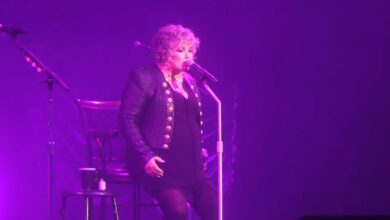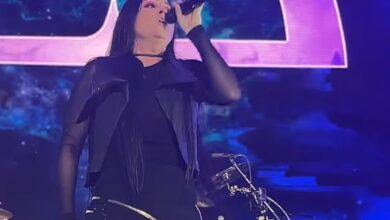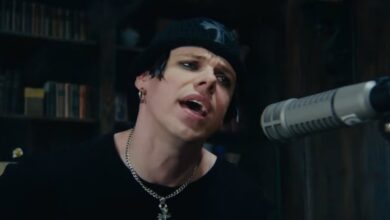The Night Prince Turned a Downpour into Legend: Purple Rain at the Super Bowl
On February 4, 2007, the grandest spectacle in American sports came to a standstill for its halftime intermission in Miami Gardens—just as the heavens unleashed a relentless rain. Beneath the pounding storm at Dolphin Stadium, Prince emerged on a stage sculpted into the shape of his iconic Love Symbol, transforming the chaos of the weather into part of the show itself. What might have been a logistical nightmare instead became performance art. Rain had never drenched a Super Bowl halftime quite like this before, turning the slick platform, the gleam of high heels, and the live electric current of guitars into a daring act of defiance. Rather than fight the elements, Prince used them as texture, letting the storm’s rhythm sync with the music as millions of viewers around the world watched a legend bend nature to his will.
The performance that followed didn’t resemble a traditional medley but rather unfolded like a cinematic event directed in real time. Thunder rolled in sync with pyrotechnics while flashes of lightning pierced the night, and suddenly a booming stomp—Queen’s “We Will Rock You”—declared the start of something monumental. With that cue, Prince dove headfirst into “Let’s Go Crazy,” his voice slicing through the storm with electrifying control. He handled the Super Bowl stage as though it were an intimate club performance—commanding yet spontaneous, calculated yet free-flowing. Every pause and surge felt intentional, designed to let the audience catch its breath just long enough before he reignited the flame. Behind his swagger, there was a director’s precision at work, using timing, angles, and pacing to create something that felt both wild and perfectly orchestrated.
Even before the first chord rang out, the road to that twelve-minute burst of genius was paved with showmanship. In the days leading up to the game, Prince broke with tradition—skipping the expected press conference and performing a surprise mini-concert instead. That gesture alone revealed his mindset: this wasn’t a promotional appearance, it was an artistic statement. According to producers, rehearsals were as intense as they were unconventional. Because the uniquely shaped stage couldn’t travel to Las Vegas, his team practiced using taped outlines on the floor, carefully mapping every move. When the real set finally arrived, Prince adjusted his steps with almost mathematical precision, balancing spontaneity and structure. Even the initial pitch meeting months earlier had its flair—he sealed the deal by launching into an impromptu private performance in a Los Angeles living room, instantly convincing everyone he was the man for the job.
The song choices alone told the story of an artist painting his own myth. Prince wasn’t merely running through a list of hits—he was crafting a musical narrative. Opening with the thunderous stomp of “We Will Rock You” and charging through “Let’s Go Crazy,” he fused bravado and freedom before weaving into “Baby I’m a Star” and echoing motifs of “1999.” From there, he surprised everyone with a string of covers that paid homage to his influences and peers—Creedence Clearwater Revival’s “Proud Mary,” Bob Dylan’s “All Along the Watchtower” filtered through Hendrix’s fire, and, perhaps most unexpected, Foo Fighters’ “Best of You,” a bold salute to a band that had once reinterpreted his “Darling Nikki.” The finale was inevitable: “Purple Rain,” reserved for the exact moment when story, sound, and sky would converge into something mythic.
While most halftime shows rely on spectacle for scale, Prince found his grandeur in people and motion. The Florida A&M University Marching 100 became his living backdrop, their glowing uniforms and synchronized precision adding visual rhythm to the music. Under the stadium lights and steady rainfall, their movements created kinetic brushstrokes for the cameras to capture—each twirl, step, and turn a reflection of the song’s pulse. Their contributions on “Baby I’m a Star,” “1999,” and the finale fused HBCU pageantry with the slick pulse of Minneapolis funk. The result was both disciplined and ecstatic, bridging generations of musical tradition and giving visual life to the collaboration between order and improvisation that defined Prince’s career.
Visually, the stage was as much an instrument as his guitar. Production designer Bruce Rogers conceived the glowing Love Symbol platform as a piece of living sculpture, pulsing with neon energy beneath a canopy of storm clouds. Camera cranes swept across arcs of light while a translucent sail lifted behind Prince to frame his silhouette in breathtaking fashion. Where most televised performances rely on close-ups, he opted for scale—wide shots that made his lone figure feel monumental against the vastness of the stage and sky. The rain didn’t hinder the visuals; it elevated them, turning droplets into prisms that refracted the lights, making every frame shimmer with divine accident. In that downpour, the storm became part of the choreography.
And then came the quote that became legend. As crew members nervously checked the slippery stage and electrical equipment, a message came from Prince himself: “Can you make it rain harder?” Those six words embodied everything about his artistry—fearless, dramatic, and poetic. While the crew worried about gear malfunctioning, Prince saw opportunity. Later, musicians recalled how the downpour grew so heavy that some instruments never worked again after the show, yet not a single malfunction occurred live. The storm was not a foe but a scene partner, lending texture and emotion. Prince didn’t perform in spite of the rain—he conducted it, treating the weather as his co-star and muse in a one-night-only performance no special effects could replicate.
Musically, he created a dialogue between eras and genres. His take on “All Along the Watchtower” echoed Hendrix’s fire without mimicry, while “Best of You” turned a 2000s rock anthem into a spiritual outcry, dripping with soul and defiance. “Proud Mary” pulsed with a groove that nodded to Ike & Tina Turner while keeping the energy firmly anchored in Prince’s own rhythm. Every note felt sharpened by the storm—his guitar slicing through the night like lightning itself. There was warmth beneath the sharpness, too, a human pulse that made both the drenched crowd and millions of living-room viewers feel they were part of the same heartbeat, joined by the electricity of sound and sky.
The performance wasn’t just about sound—it was about mastery over risk. Performing in high heels on a slick acrylic stage under torrential rain demanded poise that bordered on superhuman. His dancers, the Twinz, seemed to defy physics as they glided across the wet floor, each move perfectly timed to the beat. Behind the scenes, volunteers assembled and rolled the modular stage in under two minutes, like a pit crew executing a miracle. At one point, a crushed lighting cable forced a technician to hold a connection by hand through the show’s finale. Every flawless moment was the product of controlled chaos, a testament to the unseen army that helped make danger look effortless.
Television audiences crave spectacle, and the image that lingered was pure iconography. During “Purple Rain,” his silhouette appeared behind a backlit sheet, a moment so arresting that it sparked minor controversy with the FCC. Yet beyond the headlines, it became one of the most enduring visuals in music history: a lone figure, drenched and defiant, framed by purple light and falling water. It was provocative not because it pushed boundaries, but because it captured vulnerability and grandeur at once. That shadowed image still circulates every year, a shorthand for perfection under pressure and proof that one song, one scene, and one artist can turn a halftime show into a living legend.
Critics, often skeptical of halftime entertainment, were unanimous in their praise. The New York Times declared it “one of the most electrifying halftime performances ever,” while the Chicago Tribune lauded how Prince turned what many considered corporate filler into a genuine artistic moment. It reminded the world that even under the tightest constraints of time and sponsorship, music could still shock, inspire, and transcend. His set redefined what a “mini-concert” could mean, proving that a creative force could transform a marketing stage into a masterpiece of live art.
The aftermath spoke volumes. Within a week, sales of Prince’s catalog skyrocketed: physical albums jumped into the tens of thousands, digital downloads soared past six figures, and online retailers reported demand multiplying overnight. Yet those numbers only quantified what audiences had already felt—rekindled love, fresh awe, and collective nostalgia. The Super Bowl, usually an exercise in spectacle, had briefly become spiritual. For millions, that twelve-minute show wasn’t a transaction; it was a revelation, reminding everyone that authenticity still moved markets, hearts, and history.
Looking back, what stands out most is how much he shared. Prince could have filled every second with his own hits, yet he chose to elevate others—Queen, Creedence, Dylan, Hendrix, Foo Fighters—honoring the lineage that shaped him. By threading their music through his, he built a bridge between generations, culminating in “Purple Rain,” where weather and melody became inseparable. It was a gesture of generosity wrapped in genius: a reminder that greatness isn’t about self-promotion, but about connection and the joy of giving art back to its roots.
From a television perspective, it remains a textbook example of embracing danger as design. The production team faced the possibility of slips, electrical shorts, and visual haze from the downpour. Instead of retreating, they leaned into the chaos. Cameras widened their scope, framing silhouettes and glimmering reflections, transforming the storm into a cinematic character of its own. Prince trusted everyone—his band, his crew, and the cameras—to paint big and bold even when the margin for error had vanished. The result was not safety, but triumph born of total trust and artistry.
Ask anyone who saw it live, and they’ll recall the final moments. The stadium lights dimmed to an ethereal violet, ponchos shimmered like mirrored scales, and the familiar chords of “Purple Rain” rose like a benediction. It felt preordained—a song about storms now living inside one. Each note echoed through the mist, thunder answering every phrase as if nature itself were part of the arrangement. When the last chord faded, fireworks lit the drenched Miami sky, and the camera pulled away, leaving behind not a performance, but a vision—an artist ascending through sound and storm alike.
In the years since, that night has become the measure by which all halftime shows are judged. Fans and critics alike still ask whether any could ever match its power, daring, or cinematic scale. None have. Super Bowl XLI wasn’t just entertainment—it was a convergence of history, culture, and raw emotion. Prince’s set proved that a pop performance could hold multitudes: funk and rock, faith and sensuality, grandeur and intimacy, all coexisting without contradiction. It wasn’t merely a concert—it was a declaration that art belongs everywhere, even at the center of the world’s biggest game.
And in the end, it all circles back to that mischievous, immortal line: “Can you make it rain harder?” More than a quip, it was his creative manifesto. Never avoid the uncontrollable—direct it. Never shrink from chaos—turn it into choreography. Never question whether the stage can carry meaning—fill it until it does. That night in Miami, under the heaviest rain the Super Bowl had ever seen, Prince didn’t just perform. He commanded the storm, rewrote the rules, and delivered a moment that time itself still refuses to let fade.
@80sdeennice Prince sings “Purple Rain” (in the rain) in the greatest Super Bowl halftime show of all time 💜 ☔️ When the producers approached Prince before the set to warn him about the rain, he responded, “Can you make it rain harder?” #GOAT #SuperBowlXLI #2007 #prince #80sicon #80s #genx #80smusic #ilovethe80s #80skid #halftimeshow #purplerain #foryoupage ♬ original sound – 80s Deennice





